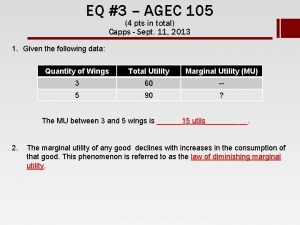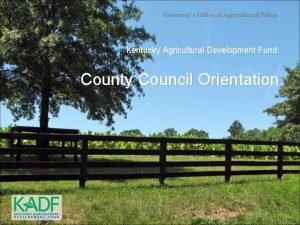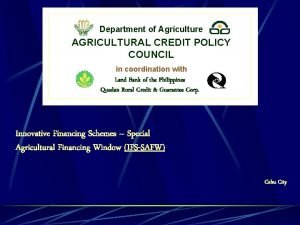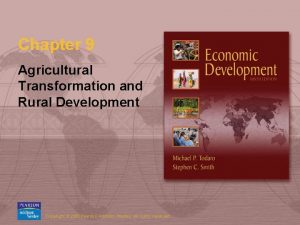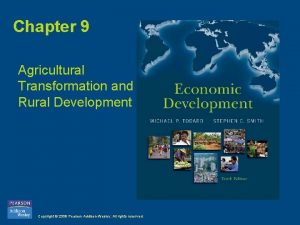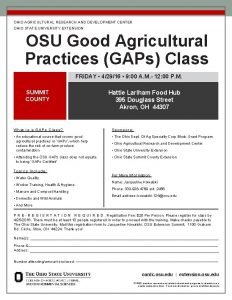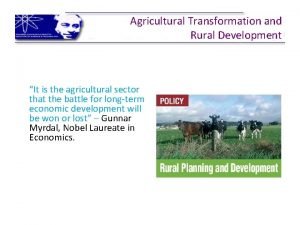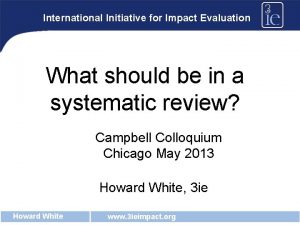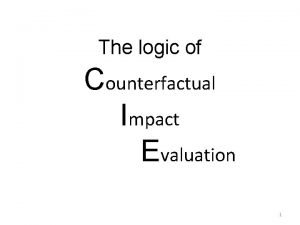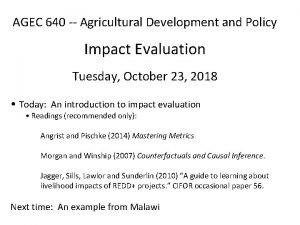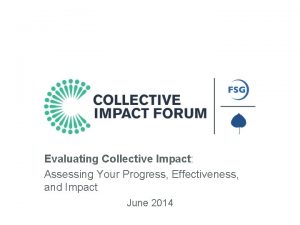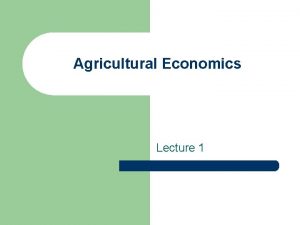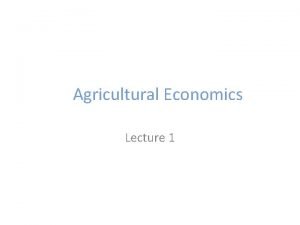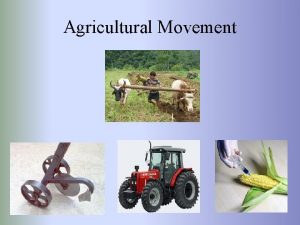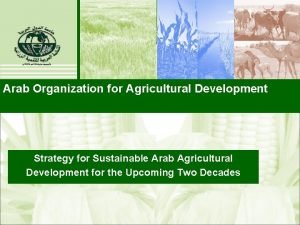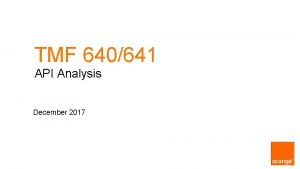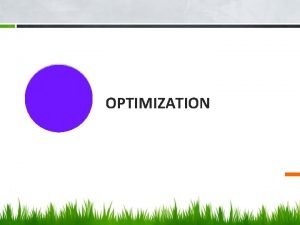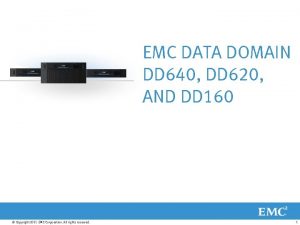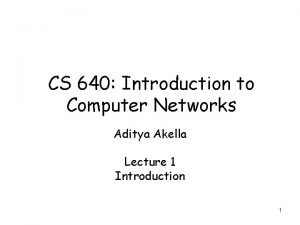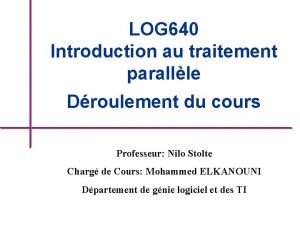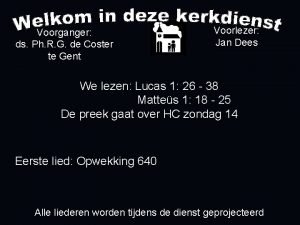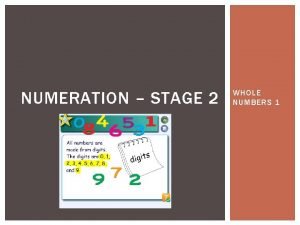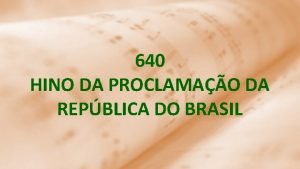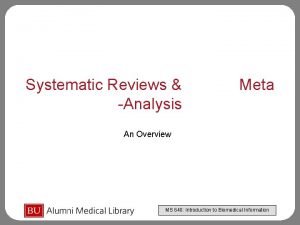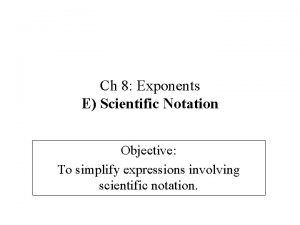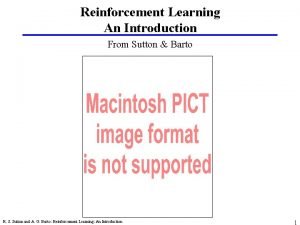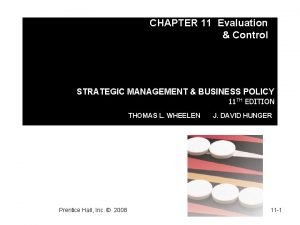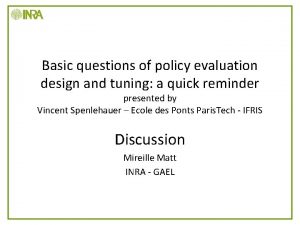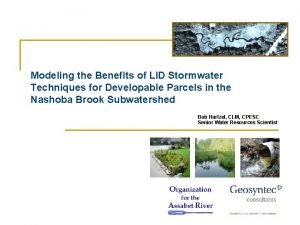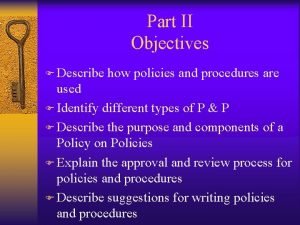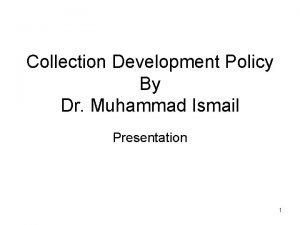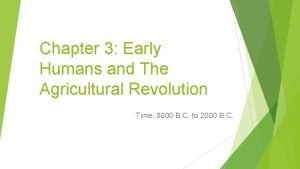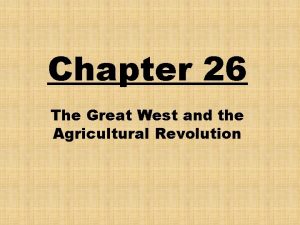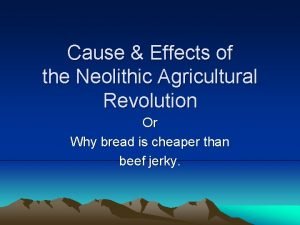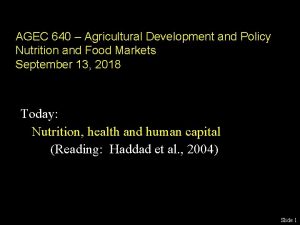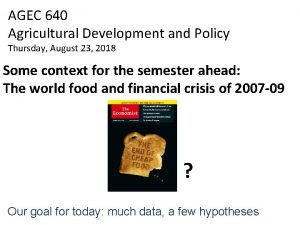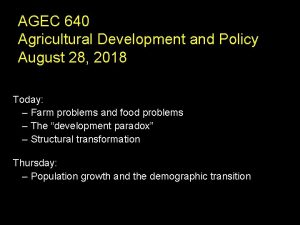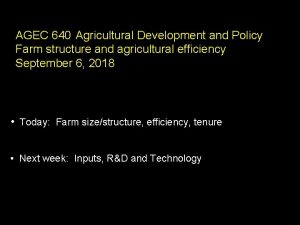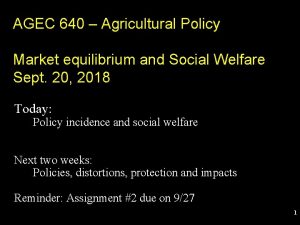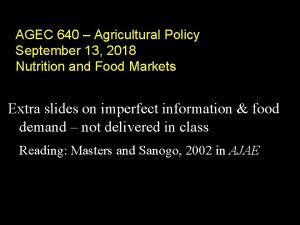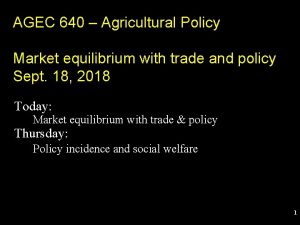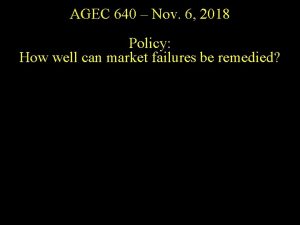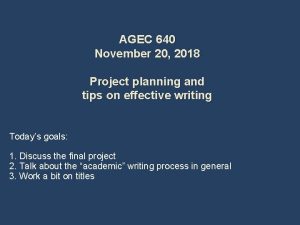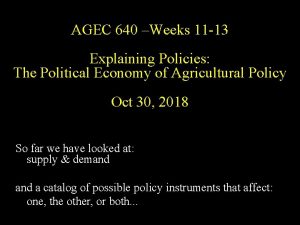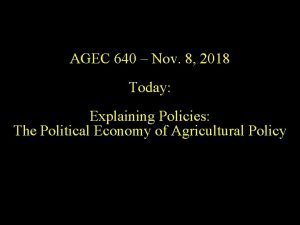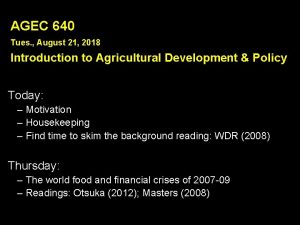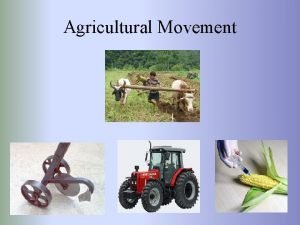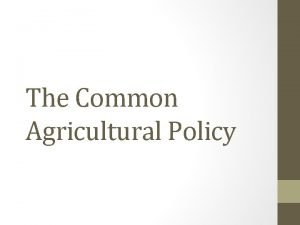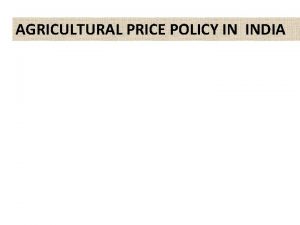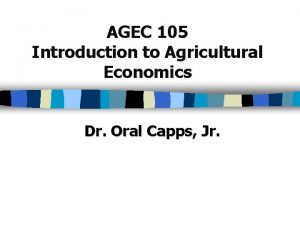AGEC 640 Agricultural Development and Policy Impact Evaluation











































- Slides: 43

AGEC 640 -- Agricultural Development and Policy Impact Evaluation Tuesday, October 23, 2018 • Today: An introduction to impact evaluation • Readings (recommended only): Angrist and Pischke (2014) Mastering Metrics Morgan and Winship (2007) Counterfactuals and Causal Inference. Jagger, Sills, Lawlor and Sunderlin (2010) “A guide to learning about livelihood impacts of REDD+ projects. ” CIFOR occasional paper 56. Next time: An example from Malawi

Evaluating Projects and Policies Types of evaluation: • M&E – track set of project indicators across space and time • Process – assess program operation and adherence to implementation design • Economic – analyze costs/benefits, incentives and behaviors (BCA/CBA) • Sector – review of sector strategy and accomplishments • Impact evaluation – establish a causal effect of a specific program or policy by establishing a counterfactual

Project impacts Outcome Impact With Project Intervention Without Project ?

M&E vs. Impact Evaluation • Traditional M&E – Measures trends in indicators and implementation – Are the benefits going to those intended? – Is the project being implemented as planned? – Not focused on causality • Impact evaluation – Measures impact on the beneficiaries that are caused by the intervention/program/policy – Asks: “What are the effects of the intervention? ” – Asks: “How would the outcome change if the program or policy changed? ” – The focus is on establishing causality (hard!!!)

Key elements of Impact Evaluation • The question of causality makes IE different from other monitoring and evaluation approaches: • Main question is one of attribution – isolating the effects of the program from other factors and potential selection bias: – Counterfactual outcomes (i. e. outcomes for participants not exposed to the program), or – Use survey data to construct comparison groups for those who are participants or receive treatment.

The Problem of Bias X T Y Expectation: T (the treatment) influences Y (the outcome) Problem: X (a confounder) influences both T and Y. If T is correlated with X, the estimate of the effect of T on Y will be biased. Goal: Break the link between X and T

Causation • How to establish that T (treatment, program, policy) causes Y (the outcome): – Does T precede Y in time? – Is T correlated with Y? – Can we rule out or control for other variables(X) that can explain the relationship between T and Y? Key: The researcher must understand the process or theory that generates the data – otherwise you can only establish a correlation between T and Y.

Approaches 1. Make assignment to the treatment group random by construction. This is normally referred to as a “Randomized Control Trial” (RCT) and is the gold standard for impact evaluation studies. (a “natural experiment” might suffice) or 2. Perform regression with adequate controls for X. This is the “standard” regression approach, but may be plagued by the problem that not all elements of X may be observed. This is the problem of unobservables and leads to omitted variable bias.

Intervention /program /policy The most effective way to link interventions/programs to outcomes is by establishing a control group Outcomes

Project impacts Outcome Impact With Project Intervention Without Project ?

Project impacts Outcome Impact With Project Intervention Without Project ?

Project impacts Outcome Impact With Project Intervention Without Project ?

Project impacts Outcome Impact With Project Intervention Without Project ?

Project impacts Project Intervention Without Project Outcome l g a n u i t s is fac M er t n u o c Impact With Project

Confounders – a challenge for causation • The counterfactual should tell us “what would have happened, had there been no policy or treatment? ” • In addition to omitted variables, policy evaluation must deal with human behavior (strategic and a source of confounding): – Mimics intervention or masks impacts – Persistent omitted variables – Lack of balance across treatment and control • Potential confounders or omitted variables in policy analysis: – Institutional factors (e. g. other programs, NGOs, etc. ) – Biophysical characteristics (e. g. soil conditions, weather) – Psycho-social behavior (e. g. volunteering or targeting) – Historical trends (e. g. technical change, political bias, institutional bias, project presence)


Research Designs Q 1→ Starting before Starting after Before-After Control. Intervention (+ retrospective) Before-After (+ modeling) Reflexive/ Retrospective

Research Designs Q 2↓ Q 1→ Starting before Starting after Budget to collect Before-After data on “controls” Control. Intervention (+ retrospective) Budget to collect data on intervention only Reflexive/ Retrospective Before-After (+ modeling)

Research Designs Q 2↓ Q 1→ Starting before Starting after Budget to collect Before-After data on “controls” Control. Intervention (+ retrospective) Budget to collect data on intervention only Reflexive/ Retrospective Before-After (+ modeling)

Research Designs Q 2↓ Q 1→ Starting before Starting after Budget to collect Before-After data on “controls” Control. Intervention (+ retrospective) Budget to collect data on intervention only Reflexive/ Retrospective Before-After (+ modeling)

Research Designs with ‘Controls’ Project Intervention Outcome without ? No Project: “Control” Impact With Project

Analysis • Simple difference in means between treatment and control/comparison groups does not account for pre-existing differences; • Multivariate regression will be valid only if all differences can be observed and controlled for; • A difference-in-difference estimator compares indicator values between treatment and control (first difference) and before and after (second difference).

BACI Comparison (Control) Control Before Control After IMPACT Project site (Intervention) Intervention Before Intervention After

Good impact evaluation will allow you to… • Confidently say whether the intended intervention is “working” i. e. effective in delivering the intended outcomes • Conditional on design, sampling and analysis – What incentives and activities are most effective? – Who benefits or loses? – Where (sites) and when (in production cycle) will we see the best results?

Example: Income Shocks in Malawi Research question: Do households use natural resources to cope with unexpected events such as income shocks? Policy importance to environmental protection and poverty reduction.

Motivation • Life is precarious in rural Malawi: • policy shocks (e. g. economic reforms) • illness & death (e. g. HIV/AIDS, malaria) • weather events (e. g. drought, flood) • Missing markets for credit and insurance • coping strategies are “informal” • forests may serve as a “safety net”

Study Sites Lake Malawi major road urban center Blantyre District Mulanje District study site V 3 V 1 V 2 Blantyre 0 12. 5 25 50 Kilometers

Fieldwork Methods • HH survey • Random selection • • • (natural experiment) Large set of variables Quarterly observations Direct measurements of outcome variables (e. g. quantity of products removed from the forest)

Sample Households, Selected Attributes Village 1 HH population FHH (%) Village 2 Village 3 4. 64 4. 79 5. 36 49 45 23 Head sec. ed. (%) Farm size (ha) 8 11 14 1. 17 0. 96 1. 94 Income $208 $156 $282 (1999 USD/person)

Empirical Approach • Quantify the “effect” of an income shock on wood extracted for marketing (e. g. , charcoal, timber, firewood, crafts, bricks, food, drink). • Treatment = an income “shock” (receipt/non-receipt of a subsidy package) unpredictable at the time (nearly a RCT) sizable impact (enough to produce an effect? )

Qty. wood extracted (kg) Marketed Wood Extraction (kg), SP Non-Recipients No positive income shock, increase in forest extraction… a b

Qty. wood extracted (kg) Marketed Wood Extraction (kg), SP Recipients Positive income shock, decline in forest extraction… c d

Difference-in-Difference (DID) without controls Recipients Non-recipients Qty. wood extracted (kg) 3000 2500 c 2000 e d DID Est. of Impact (d-b)-(c-a) 1500 1000 a b 500 0 Season 1 (Before “Treatment”) Season 2 (After “Treatment”)

Difference-in-Difference (DID) with village controls Recipients Non-recipients Qty. wood extracted (kg) 2500 2000 DID Est. w/ village controls 1500 1000 500 0 Season 1 (Before Treatment) Season 2 (After Treatment)

Empirical Approach • Base DID model: Y = b 0 + b 1 Seas 2 + b 2 Treat + b 3(Seas 2*Treat) + d. X + e DID Est. of Impact • Include interaction terms: Y = b 0 + b 1 Seas 2 + b 2 Treat + b 3(Seas 2*Treat) + d. X + g (Seas 2*Treat*X) + e DID Est. of Differential Impact

Random-Effects Tobit Regression Results forest extraction (n = 198)

Empirical Approach • Include interaction terms to examine differential effects of starter pack: Q = b 0 + b 1 Seas 2 + b 2 Treat + b 3(Seas 2*Treat) + d. X + g (Seas 2*Treat*X’) + e X’ = older household, # adult males, and distance to forest

SP Effect on Wood Extracted (kg) Differential Effect, by Householder Age 0 -50 -100 -150 -200 -250 -300 Base HHs “Older” Head (Younger Head) Mean Difference (p = 0. 023) 90% CI

SP Effect on Wood Extracted (kg) Differential Effect, by Number Adult Males 0 -200 -400 -600 -800 -1000 -1200 Base HH (No Men) One Man in HH Mean Difference (p = 0. 001) 90% CI

SP Effect on Wood Extracted (kg) Differential Effect, by Distance to Forest 0 -50 -100 -150 -200 -250 -300 Base HH 1 km to Forest (0 km to Forest) Mean Difference (p = 0. 047) 90% CI

Conclusion & Implications • Evidence Malawi smallholders use forests for shock coping • Some evidence that positive income shocks reduced forest use • Some ideas for future research: • larger sample (improved causal analysis) • longer panel (confirm validity of DID) • other shock measures • control for more (unobservable) contextual factors (e. g. , market conditions, property regime, climate, etc. )

Characterize the site Intervention Understand the intervention Test hypotheses and revisit assumptions Develop testable hypotheses Collect data Outcomes

With thanks to…. . Pamela Jagger (UNC) William Sunderlin (CIFOR) Monica Fisher (CIMMYT) Subhrendu Pattanayak (Duke University) Erin Sills (North Carolina State University) for contributions to this presentation
 Dave padgett
Dave padgett Agec 105
Agec 105 Ag revolution kentucky
Ag revolution kentucky Credit safw
Credit safw Chapter 9 agricultural transformation and rural development
Chapter 9 agricultural transformation and rural development Chapter 9 agricultural transformation and rural development
Chapter 9 agricultural transformation and rural development Ohio agricultural research and development center
Ohio agricultural research and development center Agricultural transformation and rural development
Agricultural transformation and rural development International initiative for impact evaluation
International initiative for impact evaluation Chess math
Chess math Impact evaluation
Impact evaluation Collective impact evaluation
Collective impact evaluation What is agricultural development
What is agricultural development What is agricultural development
What is agricultural development Stages of agriculture
Stages of agriculture Arab organization for agricultural development
Arab organization for agricultural development Tmf640
Tmf640 Ccna 640
Ccna 640 We need to enclose a field with a fence. we have 500 feet
We need to enclose a field with a fence. we have 500 feet Data domain dd690
Data domain dd690 Uw madison cs 640
Uw madison cs 640 Heptarchy
Heptarchy Log 640
Log 640 Ccna voice 640-461 pdf
Ccna voice 640-461 pdf Opwekking 640
Opwekking 640 Write a number in expanded form. 637
Write a number in expanded form. 637 860 en yakın yüzlüğe yuvarlama
860 en yakın yüzlüğe yuvarlama Hino 640
Hino 640 Ms 640
Ms 640 Sybex ccna
Sybex ccna 640 000 in scientific notation
640 000 in scientific notation A 640 n hunter gets a rope
A 640 n hunter gets a rope 01:640:244 lecture notes - lecture 15: plat, idah, farad
01:640:244 lecture notes - lecture 15: plat, idah, farad Sutton blackjack
Sutton blackjack Strategy evaluation and control example
Strategy evaluation and control example Policy evaluation questions
Policy evaluation questions Low impact development
Low impact development Low impact development
Low impact development Policy development steps
Policy development steps Collection development policy
Collection development policy Agricultural accounting and finance kansas
Agricultural accounting and finance kansas Chapter 3 early humans and the agricultural revolution
Chapter 3 early humans and the agricultural revolution Chapter 26 the great west and the agricultural revolution
Chapter 26 the great west and the agricultural revolution Cause and effect of the agricultural revolution
Cause and effect of the agricultural revolution

